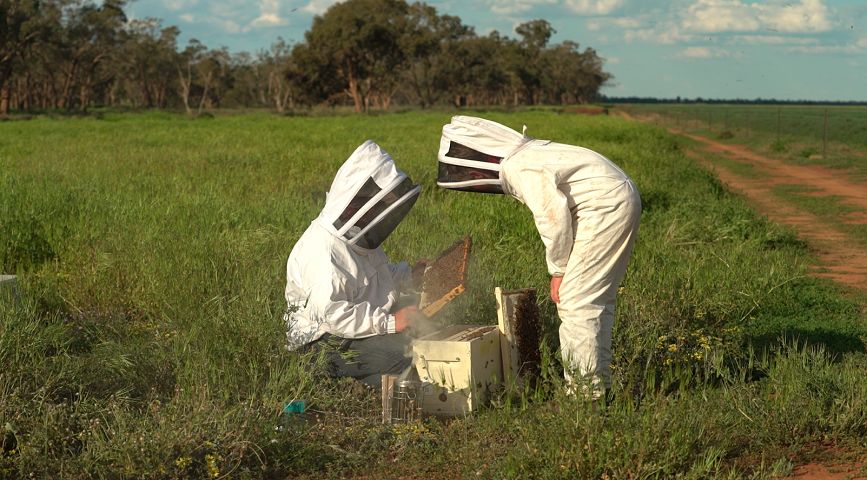Inspecting your hives – when, why, and how often?
Inspecting your hives is an essential part of beekeeping, helping you keep on top of how your colony is functioning. Do your bees have adequate food supplies and plenty of space to expand, is the hive at the right temperature, is the queen laying eggs, are there signs of invasive pests or disease? By checking your hives regularly, you can spot and resolve any issues before they become serious problems.
Of course, the benefits of inspections need to be balanced against the downsides. Opening up your hives is disruptive to your bees, no matter how careful you are, and it can take around a day for them to get back into their routine.
Getting it right means inspecting regularly – but not too often – and changing your inspection timeline based on the seasons.
What is a hive inspection?
A basic hive inspection involves opening up the hive and carefully removing the frames in each box. In the brood box, you check for eggs and capped brood to ensure the queen is laying. You can also look for the queen herself – although she’s not always easy to spot. In your honey supers, check for drawn comb and full frames – if your bees are running out of space to store honey, you may need to add another box. Depending on the time of year, you may also need to check for signs of swarming.
It’s also a good idea to look for signs of infestation or disease, and any damage to the hive itself.
Take notes about every inspection, including information about honey frames, brood, and possible signs of disease. This will help you track changes over time – it can be difficult to remember details after days or weeks.
Your hive inspection timeline
Bee colonies run on a seasonal schedule, so it makes sense that inspections should vary throughout the year as well. Spring and summer are busy seasons, with bees in full nectar collection and honey production mode. At the end of summer, the beekeeper harvests any excess honey, and the rest is stored for the winter. During the colder seasons, the bees stay inside the hive much of the time, vibrating their wings to keep warm.
Spring to early summer – 7-10 days
Very early in spring, bees can sometimes run out of honey supplies before nectar is available. This puts them at risk of starvation, so it’s important to check stores early in the season. Later on, a booming hive population can lead to bees swarming at this time of year, so you need to keep an eye on signs of a swarm.
Inspect the hives every seven to ten days, checking for:
- Queen cells – these oversized cells are a sign of a potential swarm
- Overcrowding – add hive boxes if the bees are running out of space
- New brood
- Honey and pollen stores – if the bees are almost out of food, you may need to feed sugar syrup early in the season
- Signs of disease – treat if needed
Late summer – 2-3 weeks
Later in summer, the bees settle into a routine and start putting serious honey into storage.
Inspect every two to three weeks, looking for:
- Stored honey – if frames are filling fast, you may need to add another super or harvest the excess
- Overheating – if wax inside the hive is melting or softening, you may need to move your hives into the shade
- Signs of disease or infestation
Autumn – once
When the honey is harvested, you should make sure your bees are left with enough food to last the winter. You can check the hive once, on a warm day, to make sure it’s well-supplied and ready for the coming cold season. This is also the time to reduce the size of your hive by removing extra honey supers, making it easier for bees to keep warm over winter.
Winter – once or not at all
Many beekeepers just leave the bees to it over winter, never opening the hive at all. If you live in a milder climate and you’re concerned about activity in the hive, you can check to make sure the bees have enough food to get them through. Otherwise, leave them to hunker down for the winter and open the hive on the first warm spring day.
Inspect and thrive
When you’re a new beekeeper, it can be tempting to inspect your hives all the time – after all, you want to know what’s happening inside.
While there’s nothing wrong with inspecting more frequently when you’re a beginner beekeeper, make sure you get valuable information every time you open a hive. Think about what you’re looking for before you start, and take detailed notes so you can compare activity over time.
The longer you keep bees, the easier it will be to space out your inspections. Because you’ll understand the rhythm of the hive and the behaviour of your bees, you won’t need to inspect so often and you’ll trust that the bees are working away inside.
Want to find out more about beginner beekeeping?Check out our article series here.

